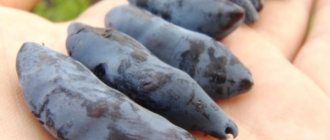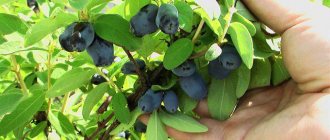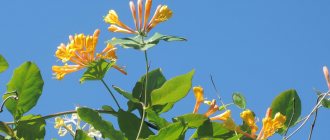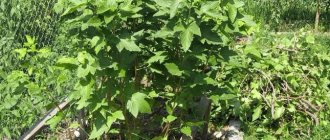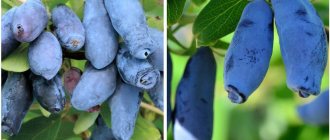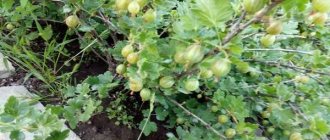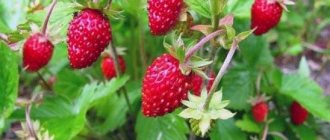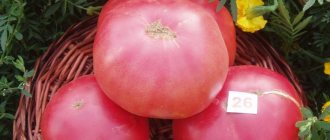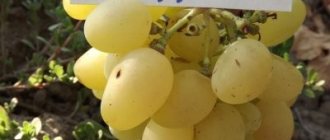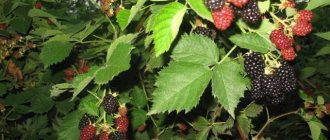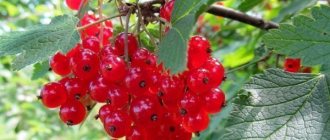Honeysuckle variety Amphora: reviews, photos, planting and further plant care
Honeysuckle (Lonicera) is very popular in northern countries. The family contains up to 200 different species. Most often found in the Northern Hemisphere. The largest amount of honeysuckle is found in the Himalayas and eastern Asia. Honeysuckle is one of the healthiest berries in terms of its composition.
It is just beginning to become widespread in Russia. Gardeners appreciated the taste characteristics of ripe berries, ease of care, and decorative properties of Amphora honeysuckle.
The content of the article:
1. Description of the variety 1.1 Fruits 1.2 Pulp 1.3 Application of honeysuckle Amphora 2. Productivity of the variety 3. Pollinator varieties for honeysuckle Amphora 4. Advantages and disadvantages 5. Planting and care 5.1 Planting honeysuckle Amphora 5.2 Planting dates 5.3 Pit preparation 5.4 Planting rules 5.5 Care for honeysuckle Amphora 5.6 Watering rules 5.7 Feeding honeysuckle 6. Pruning bushes 7. Protection from diseases and pests 8. Propagation of honeysuckle Amphora 9. Reviews of honeysuckle Amphora
Recommendations for planting
Amphora can be grown in the same place for decades, and fruiting will not decrease if the initial planting is done correctly: choose a place, select high-quality planting material, prepare the soil. Young seedlings take root well in autumn or early summer, the survival rate is at least 90%. In spring, planting is done less frequently; survival rate will be worse than in autumn. Even an adult tree tolerates replanting well, so if desired, you can dig up and move the honeysuckle.
Selecting a location
Honeysuckle loves a lot of sunlight, so the area for it should be located on a plain, without shaded areas. The berries ripen quickly and evenly in the sun, and in shaded areas fruiting lasts a little worse. It is not necessary to provide protection from the wind; the variety is not afraid of gusts, the shoots are flexible and do not break. Avoid stagnant soil and holes; the root system does not tolerate excess moisture in the soil and rots instantly.
Attention! The groundwater level must be at least 2 m to the ground surface.
Selection of seedlings
Amphora seedlings must be purchased from specialized nurseries and trusted places. The optimal age for a seedling is 1-2 years; older plants have a harder time adapting to new places. The root system of honeysuckle must be protected, since in young seedlings it is fragile and easily damaged. The bark coming away from the trunk is a normal phenomenon, so there is no need to be afraid of this fact. The seedling must have healthy young shoots; dry branches are allowed, but no more than 2-3 pieces.
Landing process
Amphora can be planted between the end of August and November, depending on the climate in the region. The earth should not yet cool down from the summer heat, but the air temperature should drop. If you plant the plants too early, then by frost it will put out buds, which will soon die from the cold. When planted in autumn, the bush will take root over the winter, and in the spring buds will bloom on it.
The hole for the seedling is dug based on the size of the root system. The bushes of the variety are compact, but the root system quickly grows throughout the area over the years. The size of the planting hole must be at least 40x40x40 cm. Drainage must be laid at the bottom to drain water, then a layer of compost (about 10 kg), organic fertilizers (a glass of ash) are added, and superphosphate (2-3 tbsp) is added. Pour a bucket of water into the hole and after it is absorbed, plant a bush and dig in with soil. You cannot shorten the seedling at the time of planting: this will cause additional stress to the crop and delay the fruiting period.
Honeysuckle Amphora: variety description
The birthplace of Amphora is St. Petersburg, VIR station. Vavilova. To obtain it, Kamchatka honeysuckle, growing in the wild, was used.
Mature shrubs reach a height of 1.4 to 1.5 meters. The stems are located strictly vertically. The crown has the shape of a circle, the foliage is dense. Honeysuckle is not only a fruit plant, it is also an ornamental crop that will wonderfully decorate any country landscape.
Honeysuckle Amphora - photo
Amphora belongs to the honeysuckle varieties with an average ripening period. After planting in a permanent place of growth, it bears fruit already in the 3rd year. The berries ripen at once. The beginning of fruiting of honeysuckle Amphora occurs after June 15, closer to the end of the month
. Ripe berries can remain fresh on the branches for a long time, which makes harvesting easier.
Fruit
Ripe berries grow quite large. The length of one such fruit is up to 2 cm. They have an elegant, oblong shape, reminiscent of a jug. The surface is covered with a smooth, rather thick peel. Color – blue-blue. There is a clearly visible wax coating. The average weight of one fruit is from 1.2 to 1.5 g
. There are some specimens that reach 3 grams.
Photo of honeysuckle Amphora
Pulp
Quite dense. There is no aroma. The taste of Amphora honeysuckle is complex, sweet and sour with the presence of bitterness and an aftertaste similar to the taste of lingonberries. On a 5-point scale, the Amphora variety received a high score of 4.5 points
.
Application of honeysuckle Amphora
Amphora is a dessert variety
. The berries are good fresh, unprocessed. You can prepare homemade preparations. For example, juices, fruit drinks, compotes.
Honeysuckle Amphora - video
Features of cultivation
The bush begins its spring awakening very early, so autumn planting, in September, is the best option. Only in the south can the crop be replanted until mid-March. You need to take the selection of a place for a seedling seriously.
Honeysuckle Amphora grows in any conditions, including in the shade. At the same time, the shrub is photophilous and bears fruit better in warm and moderately rainy weather. In the sun, the berries of the Amphora variety are tastier and sweeter.
Honeysuckle bushes are planted at intervals of 1.5-2 m.
Advice! A seedling with a closed root system is also planted in the spring.
For Amphora honeysuckle, choose a sunny place or with light partial shade if the bush is grown as a fruiting bush. In the shade the plant will develop, but is unlikely to bloom.
Can be planted in an open place; honeysuckle is not afraid of cold wind. Although this will also have a negative impact on the quality of fruiting.
The plant is moisture-loving, but does not develop well in swampy soil and in areas where spring or rain water accumulates. Honeysuckle cannot be placed in lowlands.
Light soils, slightly acidic and neutral, are suitable for shrubs. On heavy soils, a substrate is prepared in the hole from equal parts of local fertile soil, humus and sand. Experienced gardeners advise placing the bush in the light afternoon shade of an apple tree, which is considered a favorable neighbor for honeysuckle.
Advantages and disadvantages of the variety
Enough is already known about the advantages and disadvantages of the variety.
Amphora honeysuckle has much more advantages:
- large fruit size;
- excellent taste of honeysuckle Amphora;
- frost resistance of the honeysuckle variety Amphora;
- low maintenance requirements;
- there is no secondary flowering;
- fruits tolerate transportation well;
- useful composition;
- After ripening, ripe fruits do not shed.
Among the disadvantages, one can highlight the variety's need for pollinators.
Characteristics of the variety
The homeland of this variety is St. Petersburg. The ancestor is Kamchatka honeysuckle. 1998 is the year when the plant was officially registered in the State Register of Breeding and Horticulture in the Russian Federation.
The first harvest of Amphora honeysuckle can be tasted in the 3rd year after planting. The berries ripen at the end of June; they do not fall for a long period of time. The variety is distinguished by large fruits and cold resistance.
An overview of the honeysuckle variety “Amphora” is presented by the gardener in the video below:
Pollinators
The Amphora variety is a self-sterile plant, so other varieties must be planted next to it. The best pollinators for this honeysuckle are:
- Violet;
- Gzhelka;
- Viola;
- Moraine;
- Bazhovskaya.
Shrubs are planted 1.5-2 m apart from each other; they must be placed in one row or in a group.
Features of fruiting
One healthy bush brings about 1.5-2 kg of useful fruits. Everything directly depends on the climate in which honeysuckle grows and the quality of care for the bush. There are cases when fruits appear in the 1st year after planting - these are signal berries.
The shrub can produce a full harvest only in the 3rd year after planting. The berries of the bush are firmly attached to the branches, so when harvesting you will have to try to remove them. The fruits tolerate transportation well.
In the Moscow region, the plant bears fruit at the beginning of summer; in cold regions, the fruits ripen in the middle or end of June. But this still happens before the strawberries or raspberries fully ripen. With good care, the shrub can live for about 30 years, the yield does not change over the years, and the berries do not become smaller.
Plants have been documented that bear berries for more than 80 years in a row.
Honeysuckle berries are unique; they make excellent jam with a slightly bitter aftertaste. The fruits can be frozen and made into nutritious jam.
Honeysuckle Amphora: planting and care
For planting, you need a place with sufficient sunlight, protected from wind and drafts. Amphora can grow in shady areas when the area is well blown by the wind, but in this case you should not count on a high and high-quality harvest.
The ideal soil for planting honeysuckle is either neutral or slightly alkaline.
. To reduce the acidity of the soil, add lime, chalk or ash to the hole.
Planting honeysuckle Amphora
A tree between 2 and 3 years old is suitable for planting. There should already be a sufficient amount of foliage on it.
Planting honeysuckle
Honeysuckle Amphora: planting dates
Amphora honeysuckle is planted from August to September.
. This is due to the early onset of the growing season. There is an early awakening, already in March. A plant planted in spring may have difficulty forming. In the south, planting in spring is possible. Here the snow melts early, no later than mid-March.
Pit preparation
A bucket of compost, ash, and a few spoons of inorganic fertilizer are added to the hole for the young tree. Everything is carefully mixed and left in this state for 14 - 21 days.
Landing rules
Nutrient soil is added to the hole, after which the soil is moistened
. A mound is formed in the center and a seedling is placed. The root system is carefully straightened. The root collar is buried 3 cm deep into the ground. The rest of the hole is filled with soil, compacted and moistened.
After this, the top is covered with mulch, for which peat, humus or sawdust are used.
A newly planted plant should not be pruned.
. This will only make the seedling weaker and affect its further development and the appearance of fruits.
For better survival, use plants from 2 to 3 years old with a well-developed root system. The diameter must be at least 20 cm.
Honeysuckle care Amphora
Further care of Amphora honeysuckle includes: loosening, weeding, watering, fertilizing, pruning. The older the shrub, the more carefully the loosening is carried out so as not to injure the overgrown roots.
Rules for watering honeysuckle
The regularity of watering depends on climatic conditions. So, in the south of the country they irrigate every other day. In the middle zone it is also necessary to systematically moisten the soil. This is especially true during the formation of the ovaries, before the fruit begins to appear. Watering is carried out after the harvest has been harvested. In July or August.
Advice!
To moisten the soil, make a furrow 10–15 cm deep and fill it with water. The soil should not stick together. A crumbly consistency is the most suitable.
During drought, honeysuckle is watered both in the morning and in the evening. The sprinkling method is used using a dispersed nozzle. This will keep the still fragile, tender leaves from drying out.
Watering rules
Feeding honeysuckle Amphora
The amphora begins to form fruits in the 3rd year. At this time, soil enrichment is especially required.
In early spring, mulch with humus and compost.
Before flowering, as well as during the formation of ovaries, add mullein infusion in a ratio of 1:10.
At the end of the summer period, add organic fertilizer containing potassium. For 10 liters of water there is half a liter of wood ash.
Minerals are added as fertilizing for Amphora honeysuckle; in the spring, a urea solution is applied in a ratio of 20 grams per 10 liters of water. After harvesting, add a solution of 10 grams of urea, nitrate (from ammonia) - 20 grams, superphosphate (60 grams) per bucket of water.
For August feeding, take superphosphate (60 g) and potassium sulfate (40 g) per 20 liters.
Agricultural technology
Despite the fact that the plant is not too capricious, it has its own nuances of planting and care, which will be discussed below.
Selecting a location
Choose a sunny location for planting. Honeysuckle will also grow in a very dark space, but it will produce better yield in a sunny area. But winds and drafts are not dangerous to the plant and do not affect its viability.
But it will still be safer if there is a fence near the bush, because the wind can damage the tender shoots. Other varieties of honeysuckle can become excellent neighbors for Amphora; it also gets along well with jasmine and lilac bushes.
Planting and care
The most optimal time for planting honeysuckle is from August to early November. In spring, planting is excluded, since at this time the bush should already take root and begin to grow, and the buds should swell. Amphora seedlings that are 2–3 years old are most suitable for planting.
Amphora requires stable average soil moisture. The ideal option is neutral soil with acidity up to 8.5 units, well saturated with organic fertilizers.
If the acidity of the soil is high, then the hole for the young seedling should be prepared: add chalk, ash or lime there. In any case, regardless of the acidity of the soil, mineral fertilizers are placed at the bottom of the hole so that the seedling takes root better.
The general landing algorithm is as follows:
- Dig a hole the size of the roots of the plant you are planting.
- Place drainage on the bottom.
- Add 1 bucket of compost, 1 liter jar of wood ash and about 60 g of phosphate fertilizer (superphosphate) on top.
- Stir and leave the mixture to settle for 2 days.
- Pour the resulting mixture with a bucket of water.
- Place the seedling in the center of the hole, remembering to spread the roots well.
- Place a fertile layer of soil on top and water again.
- Cover the surface of the soil with organic mulch. This will prevent moisture evaporation.
If you plan to plant several honeysuckle bushes, then the distance between them should be about one and a half meters. For complete care, do not forget to regularly weed and prevent the proliferation of unwanted plants.
Since you added a sufficient amount of fertilizer when planting, you don’t have to feed the bush for a long time. From about 3 years of age, when fruiting begins, Amphora needs feeding. Organic fertilizers (compost, humus) are best suited for these purposes in spring, and in early autumn - wood ash in the amount of 0.5 liters plus 2 tablespoons of phosphorus fertilizer.
But if you still set out to harvest berries in large volumes, then when the growing season begins, that is, when the snow melts in the spring, water the bush with urea diluted in water (1 tablespoon per bucket of water).
Important! Water the Amphora regularly, but make sure that there is no stagnation of water in the soil or that the soil is not waterlogged. This negatively affects the condition of the bush.
Features of pollination
Amphora is not a plant that can bear fruit on its own. Honeysuckle varieties mutually cross-pollinate, so experienced gardeners recommend planting several different mutually pollinated varieties of honeysuckle at a distance of up to 2 meters from each other.
For example, for Amphora, the best pollinators are varieties of the same crop: Viola, Nymph, Violet, Malvina, etc.
The leaders among insects in pollinating honeysuckle are considered to be bumblebees, which can be attracted with a sugar solution: 2 tbsp. l. Dilute sugar in a bucket of water and spray the plant immediately after flowering begins.
Disease and pest control
Despite its disease resistance, Amphora can be susceptible to attack by insects such as honeysuckle fingerfly, aphids, leaf roller caterpillars, and willow scale insects. They harm young shoots and leaves.
When controlling pests, it is important not to use pesticides so as not to spoil the harvest, so it is better to give preference to bioinsecticidal preparations that do not contain poisons: “Fitosporin” (will also help in case of powdery mildew appearing on the foliage), “Fitoverm”, “Agravertin”, “Gamair” ", "Biotlin", "Iskra bio", etc. Spraying is best done in the evening, and for the best effect after the procedure, cover the bush with film overnight. Berries after such treatment are allowed to be consumed no earlier than 5 days later.
Did you know? Folk remedies are also used to combat aphids. It is known that the insect cannot tolerate some plants: garlic, onion, chamomile, wormwood, thyme, celandine, calendula, peppermint, etc. From them you can prepare infusions for spraying or use essential oils with strong odors.
“Flint”, “Topaz”, “Skor” are suitable against fungal diseases. And to prevent fungal diseases in early spring, you can treat the plant with a 5% urea solution. To increase the overall immunity of Amphora, it is advisable to treat it with Zircon or Epin.
Pruning and crown formation
Starting from three years of growth, the bush can be pruned. For sanitary purposes, preferably in the fall, pruning of broken, dried, weak or diseased branches is carried out. Usually up to 10 of the strongest branches remain, which subsequently produce a good harvest.
From the age of 6, it is necessary to carry out regular anti-aging pruning of the bush: 2-3 non-fruit-bearing shoots, located mainly at the bottom near the ground, are removed. In general, there are no strict rules for pruning honeysuckle; they simply remove obviously unnecessary branches to thin out the space. This is done in spring or autumn, when there is no foliage and the branches are clearly visible.
A 15-year-old bush must be completely rejuvenated: cut out about half of the shoots and feed well. Under good conditions, honeysuckle grows and bears fruit for 20–30 years in one place.
Wintering
Amphora is winter-hardy and tolerates low temperatures well, but it is still worth helping the plant prepare for winter. To do this, before the first frost, water the soil generously, since then it will no longer be possible to irrigate the bush.
When the first snow falls, young fragile seedlings can be sprinkled with it. If you are worried about their stability, cover them with agrofibre. But it is not necessary to cover adult shrubs for the winter.
Protecting honeysuckle from diseases and pests
Honeysuckle Amphora is vulnerable to fungal attack only in the summer, subject to frequent rains. Common diseases include penosporosis and rust.
Prevention is necessary in spring:
- urea solution (5%);
- "Aktellik", "Rogor" (0.2%).
After harvesting, shrubs should be treated with one of the following fungicides:
- "Skor";
- "Strobe";
- "Flint";
- "Topaz".
To strengthen the protective functions, spraying with preparations such as Epin and Zircon is suitable.
Aphids may appear on newly planted shoots. Often bushes are affected by either whitefly or scale insects.
Hot pepper tincture helps against aphids.
When the plant already has fruits, it is recommended to use only organic products, such as Fitosporin, Gamair, etc.
Fruit trees:
Peach GREENSBORO Pear MARBLE Apricot LEL
Pest and disease control
- In seasons with dry and sunny weather, Amphora honeysuckle bushes are practically not threatened. But high humidity worsens the situation. But it is important to remember that any treatment of the plant with a fungicide is carried out only after harvesting.
- For urgent control of insects or diseases during the period of formation and ripening of berries, biological agents are used, such as Fitosporin, Gamair, Alirin-B.
- After harvesting, Fitoverm, Inta-Vir, and Actellik are used to kill pests. Flint, Topaz, Skor or Strobi are used against fungal diseases. Amphora bushes can also be treated with a drug that will increase its natural resistance to disease - Zircon or Epin.
Reproduction of honeysuckle Amphora
Amphora propagation occurs with the help of shoots. To do this, the lower branch is fixed on the surface of the earth in a dug groove. The top should remain on the surface itself. The shoots need to be moistened frequently.
When new shoots form, they are replanted either in spring or autumn. To do this, use a sharp shovel, which is used to divide the bushes or use already cut cuttings.
Interesting!
Honeysuckle berries contain a significant amount of ascorbic acid (200 mg), potassium (80 mg), phosphorus and sodium (40 mg), calcium and magnesium (20 g). Strontium, aluminum, copper, and some other substances are also present. 100 g of fruit contains: dry matter (13.8%), sucrose (7.6%), acid (2.6%).
The berries are covered with a thick peel, thanks to which they are perfectly stored and can be transported over long distances, maintaining their fresh appearance, taste, and aroma.
A simple way to propagate honeysuckle - video
Reproduction
Since honeysuckle is cross-pollinated, it is not propagated by seeds. In order to preserve all the properties of the parent bush, it is propagated vegetatively.
Amphora is planted using seedlings. If you have a good mother bush that has already produced fruit, you can propagate the plant using layering, cuttings, or dividing the bush. When choosing seedlings, it is important to specify the variety so that instead of an edible variety you do not purchase a decorative one.
When buying seedlings, it is better to follow a few tips:
- It is best to buy bushes that are 2-3 years old and that already have several branches and reach a height of 30-40 cm;
- the branches are flexible, not damaged and not dry, sometimes the skin may peel off on them, which is considered normal;
- the seedling must have a well-developed root, and the bush must have buds on its branches;
- You need to buy different varieties, since the plants are cross-pollinated. For pollination, the most appropriate varieties are needed.
Honeysuckle Amphora: reviews of the variety
Ksenia, 36 years old, Kurgan I chose Amphora for mine because of its resistance to low temperatures. The harvest is good even in a cold spring. Large berries. I really like the sweet and sour taste with some bitterness. I prefer honeysuckle in its raw, fresh form. Sometimes I make fruit drinks and compotes. In these cases, the bitterness disappears.
Vyacheslav, 47 years old, Krasnoyarsk We have been familiar with the honeysuckle culture for a very long time, almost from the very beginning of purchasing a summer cottage. In my opinion, this is the most delicious and, importantly, healthy berry. For us, it ripens very first, even before strawberries.
Victoria, 56 years old, St. Petersburg Our whole family loves honeysuckle, and therefore we have allocated a sufficient amount of space for it in the garden. It took a long time to choose the right variety. We decided to settle on honeysuckle Amphora and Altair. The first variety was recommended by friends. Additionally, we read reviews on the Internet. In my opinion, the variety has no disadvantages. Being unpollinated is not a problem. Altair, also a worthy variety, was planted nearby. Caring for the crop is simple. But the fruits are simply delicious. We eat it fresh, as it is healthier and no less tasty. I recommend for growing.
Why is honeysuckle interesting?
Honeysuckle is a favorite berry of residents of the CIS countries. It ripens much earlier than raspberries and is significantly superior to it in the amount of nutritional components. The shrub is grown not only for eating fresh fruits, but also for decorating a garden plot. Gardeners love to grow honeysuckle because it is unpretentious and can grow in any climate.
The second feature of honeysuckle is its amazing healing properties. The fruits contain a large amount of vitamin C and a number of microelements important for the body. Berries have an antipyretic effect, so they should be eaten when you have the flu.
Honeysuckle occupies one of the leading places in folk medicine. The berries of the bush are used as an antimalarial and diuretic. The fruits are an excellent antiseptic. The medicinal properties of the plant do not end there; a large number of delicious dishes can be prepared from honeysuckle, such as jams, preserves and jellies.
Amphora
- The honeysuckle variety Amphora was bred by crossing the Roxana variety with Kamchatka wild honeysuckle. Amphora is a mid-late variety. It grows as a bush that reaches a height of no more than 1.5 m and has a thick, round, compact crown.
- The skeletal branches of the bush are straight, not thin, directed towards the top at an angle. They have a crimson-brown color. Young shoots are crimson in color and covered with hairs. The leaves are green, oval in shape, elongated. The leaf is concave in the middle, dense and fleecy.
- Amphora honeysuckle flowers are shaped like bells. They are yellowish-green in color, the stamens extend beyond the edge of the anthers. The flowers are heavily pubescent. The fruits are dark blue berries about two centimeters long.
- Honeysuckle Amphora grows in bushes of beautiful decorative shape; they not only produce tasty fruits, but also decorate the area.
Honeysuckle care
The culture is considered undemanding, but this does not mean that the bush is left without care. It is necessary to water the berry garden, feed it, and trim it in a timely manner. With careful care, the Amphora honeysuckle variety will bear fruit for a long time.
You may be interested in: Tomatoes and peppers in the same greenhouse: can they be planted, rules of the neighborhood? Is it possible to plant hot peppers next to cucumbers? Peppers and eggplants in the same greenhouse: can they be grown next to each other?
Trimming
The first major pruning of bushes is carried out at the 3-4th year, removing aged shoots. In the first years, it will be enough to remove diseased, weak branches, as well as shoots with unblown leaves.
At about 5-6 years, honeysuckle is thinned out, repeating the procedure every season. Pruning is done in spring and autumn using sharp pruning shears.
Watering
This variety of honeysuckle is not particularly demanding of water. Watering is required during particularly hot seasons, as well as during berry ripening. Experts also recommend watering the shrub in the fall, before the first severe frosts.
The rest of the time, berry growers have enough precipitation.
Feeding
If sufficient fertilizer rates are applied before planting seedlings, there is no need to feed honeysuckle in the first 2-3 years. The plant will have enough nutrients contained in the planting holes.
Starting from the third year, organic matter is added in the spring (compost, diluted mullein or poultry droppings), and ash infusions are added in the summer and autumn. An infusion of ash, which every gardener can make, is also used for spraying honeysuckle (feeding and protection against diseases). Young Amphora bushes respond especially well to such treatments.
You should very carefully feed honeysuckle with mineral fertilizers, as this causes a strong thickening of the plant crown, a decrease in the number of ovaries, and a drop in yield.
Gardening tips
To obtain as many berries as possible, the variety must be pollinated. Not only pollinating varieties will help with this, but also insects. The best among them are considered to be bumblebees, which are more willing to fly to large landings. Therefore, it is better to plant shrubs not in a row, but in groups - in clumps. Spraying the bushes with a sugar solution will be no less effective. This requires 2 tbsp. l. sweet crystals should be dissolved in a bucket of water and sprinkled generously on the bushes at the beginning of flowering.
Annual thinning of the bush also helps to increase productivity. Honeysuckle has a very dense crown, so insects cannot get inside it to pollinate all the flowers. From the fourth year of the bush’s life, thinning pruning must be done.
Birds love honeysuckle berries. In order not to be left without a harvest, it is necessary to protect the bushes with a net or place a scarecrow.
A real find for the northern garden is the Amphora honeysuckle variety, which tolerates frost well and is very unpretentious. The crop begins to bear fruit early, and even a novice gardener without much experience can cope with the growing process. In addition, honeysuckle bushes look very decorative and will become a real decoration of the garden.
Reviews from summer residents
- The Amphora variety initially attracted me with its resistance to winter and frost, as well as its ability to bear fruit well, even if the spring is cold. The berries of this honeysuckle are large and have a sweet and sour taste. They can be eaten raw and made into jam. Sometimes the berries have a slight bitterness, but this is not the case in compote or jam.
- We have been growing honeysuckle at our dacha for a long time. A very tasty and healthy berry. Sometimes in a cold year it even ripens before strawberries and makes it possible to enjoy the first vitamin-rich berries. Previously, we didn’t think much about varieties, but when we decided to plant new bushes to get a larger harvest, we chose the Amphora variety.
- My husband and I decided to plant honeysuckle in our dacha. We chose edible. They were guided by the fact that the bushes not only bear tasty fruits, but also look good decoratively. We chose the Amphora variety; its berries make very tasty jam. Sometimes I simply grind honeysuckle berries with sugar, which makes very tasty and healthy raw jam.
Reviews from gardeners
Evgeniy, Kaliningrad: “I chose the honeysuckle variety Amphora based on reviews, the crop is unpretentious in care, does not require shelter for the winter, and bears fruit consistently. To increase productivity, I regularly apply fertilizers and water the bushes.”
We recommend checking out Barberry Red Rocket
Olga, Barnaul: “Amphora is a winter-hardy honeysuckle variety that can withstand cold spells and bears fruit consistently. The berries do not fall off the bushes. The crop is resistant to diseases and insects, but for prevention I spray the bushes with special products.”
Features of fruiting
The fruits and amphoras ripen at the end of June, and this happens almost simultaneously. If there is no strong wind, ripe berries can hang on the branches for about 2 weeks, patiently waiting for picking. Amphora cannot be unambiguously classified as a high-yielding variety of honeysuckle - from one bush, depending on care and climatic conditions, you can harvest from 0.8 to 2 kg of berries.
Features of further care
Honeysuckle grows on its own on the site, only occasionally requiring attention from the gardener. Amphora is not a capricious variety; you don’t have to fuss with it, constantly fertilize and water it, so in most cases there will be no hassle. For good fruiting, annual pruning is carried out, the soil is not allowed to dry out, and fertilizing is periodically applied to mature trees.
Watering rules
Although the shrub can withstand drought, drying out the soil too often can lead to small fruits and a bitter taste. If there is periodic precipitation in spring and summer, then there is no need to additionally water the honeysuckle. If the summer is dry, then watering is carried out once a week. The consumption rate for 1 bush is at least 2 buckets of clean, cool water. For irrigation, make a groove 10 cm deep along the diameter of the tree trunk circle. Water is poured into it, so the liquid will not spread over the entire area.
On a note! To retain moisture in the soil, the ground is mulched with humus or freshly cut grass. Mulch protects the roots from overheating.
Trimming
The first pruning is carried out when the plant is 3 years old or more. The main purpose of pruning is to prevent diseases, since infections often spread from old and dry shoots to healthy branches. The shoots are pruned in the fall, when sap flow slows down, from about mid-September. First of all, diseased, dried branches are cut off with pruning shears or a saw. On adult bushes that are 6-7 years old, you need to cut off the non-fruit-bearing branches located in the lower part. Old honeysuckle (later than 10 years old) is pruned completely in the fall, shortening all shoots to 15-20 centimeter stumps.
Tips for growing grapes
Honeysuckle Blue spindle: planting and caring for the variety
Honeysuckle Nymph - how to plant and grow on your site
Honeysuckle Cinderella: description of the variety and characteristics of the berries
Using fertilizers
The young plant does not need feeding for another 2 years, since nutrients were probably added to the soil when it was planted, and the effect from them will last for a couple of years. Starting from the third year of cultivation, honeysuckle is fed in the spring with organic fertilizers: humus is added to the ground, ash is poured near the tree trunk, and the bush is watered with liquid mullein. During the formation of buds and fruits, no feeding is done, but at the end of fruiting they are resumed. In autumn, mineral fertilizers based on potassium and phosphorus are added to the soil.
Pest treatment
During the ripening and flowering period, honeysuckle attracts the attention of aphids and leaf roller butterflies. If insects are noticed, then they need to be dealt with urgently. Bioinsecticidal preparations are effective against them. They have a powerful composition, so pests will leave the area soon after a couple of treatments, and the plantings will be preserved. Chemical additives must be used in strict accordance with the instructions. Treatment is carried out at least 4 weeks before harvest, otherwise the fruits will spoil. Folk remedies will help repel insects from the area due to their pungent odor: spray honeysuckle with infusion of tobacco leaves, tomato tops, and onion decoction.
Preparing for winter
After leaf fall, all fallen leaves and the remains of organic mulch near the tree trunk are removed with a rake. Insect larvae and disease spores can successfully overwinter in them; to prevent infection, the garden must be kept clean. Water the honeysuckle with 2-3 buckets of water, then pour 100 g of superphosphate into the ground, mix, and then lay mulch.
Amphora normally tolerates even severe frosts of forty degrees, so there is no need to wrap it up for the winter; mulching will be enough. Fallen snow will prevent the roots from freezing, and in the spring after it melts it will well moisten the dry soil. Birds pose a danger to shrubs in winter: they love to peck fruit buds. To protect plants from birds, a net is pulled over the honeysuckle or covers are placed on the bushes.
On a note! Before the first wintering, young seedlings need to be covered with spunbond or agrofibre.

